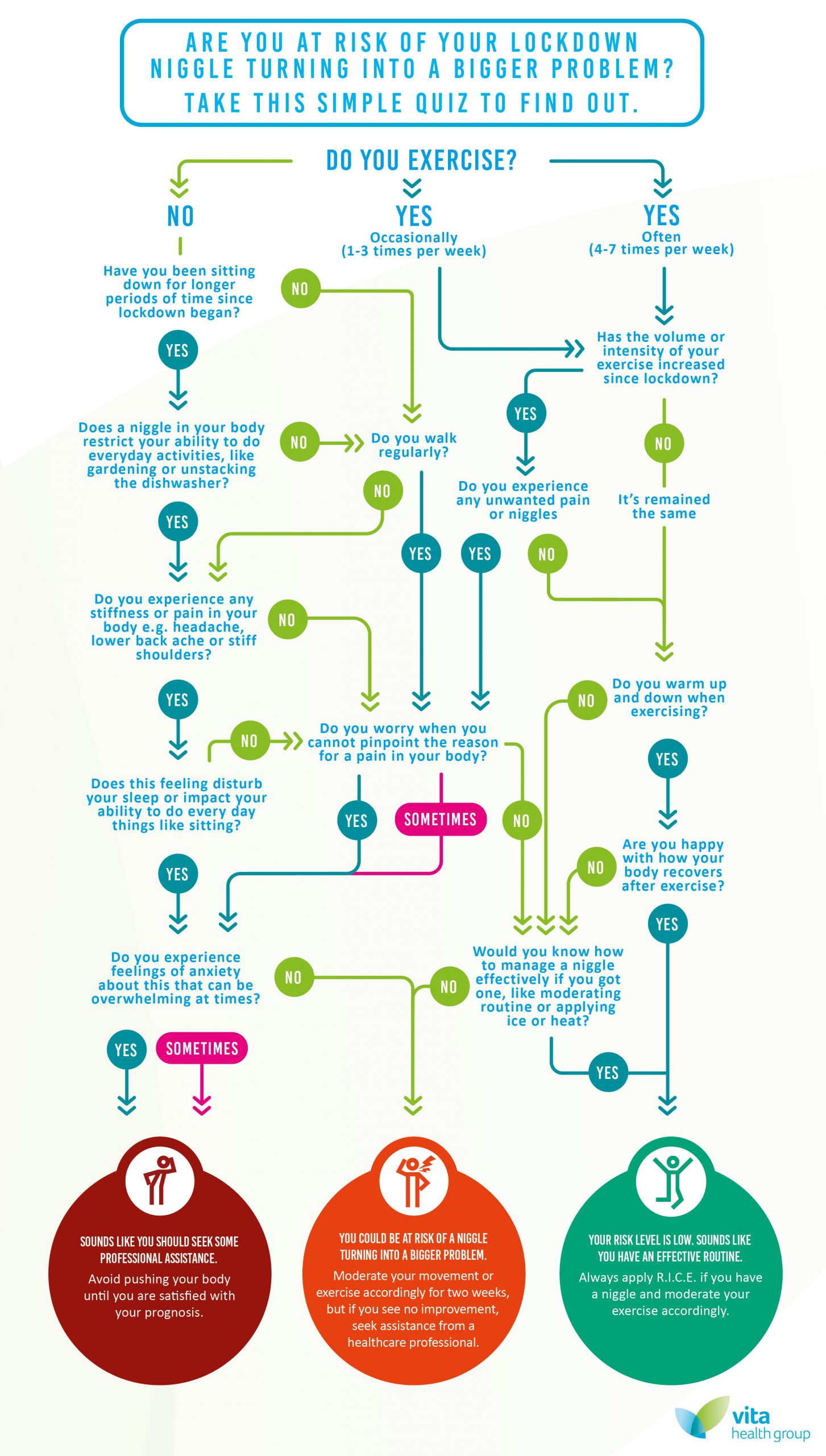By Ann Kuan, Senior Private Physiotherapist at Vita Health Group
Our backs have undoubtedly felt the strain of lockdown. From binge watching movies in bed, to sitting at our kitchen tables hunched over our laptops, to an influx in people getting fit. Our bodies, and more specifically our backs, have felt the impact.
Non-specific lower back pain i.e. a pain that is not due to a serious disease and where the exact cause of the pain is unclear, is a complaint that we have observed in our practices a great deal recently. As you might imagine, the causes of this pain are very varied. Saying that, one commonality is that, almost all lower back issues tend to result from an increased volume, intensity and frequency of some form of activity, which, if managed appropriately early on, could have been prevented.
So, just what is causing this pain in our backs?
The new work from home environment has meant that many people have been sitting in less ergonomic positions and for much longer periods of time. With people dropping their daily commute, working through lunch and missing out on those regular photocopier chats at their offices, people have been sedentary for much longer periods.
The other thing we have witnessed is a greater number of people taking up exercise over the lockdown period. Whilst this is, of course, a good thing for both mental and physical health, we have found that many people went from ‘zero to hero’ very quickly. For instance, at the start of lockdown and when many of us were only allowed out once a day, we saw a number of people going from doing very little fitness, to increasing the volume of their workouts fivefold. People who were perhaps used to doing just one run a week, started running every day and for longer distances. And if they weren’t running, they were cycling or walking further. Likewise, those who were self-isolating or restricted on leaving the house, switched from the odd gym session to doing daily online workouts, often at a much higher intensity.
We also witnessed a big boom in people purchasing fitness equipment. So much so in fact, that many of the big providers sold out completely. Unfortunately, in some cases, this resulted in people buying whatever they could for fear of losing out and thus working out with equipment that was perhaps unsuitable for their fitness level. The other issue this caused was a number of people with a great deal of fitness kit, yet without the knowledge on how to use it correctly.
On top of this, with so many people juggling childcare, home-schooling and working from home, trying to squeeze in a workout in such little time was (as you would expect) tricky. As such, we found that many people often scrimped on warm ups, cool downs and stretching – sometimes doing none at all.
And it wasn’t just exercise that people were going overboard with either. DIY and gardening boomed during lockdown, leading to many people bending over weeding for hours on end, trying to reach those difficult places when painting and assuming some very interesting positions to hammer in those nails.
All of the above elements led to a number of issues for Brits’ backs. Put simply, our bodies simply weren’t used to the increased volume, frequency and change in intensity of these activities, and our backs definitely felt the strain.
With a number of regional lockdowns potentially coming down the line, what can we do to ensure we take care for our backs, nip pain in the bud early on, and ensure a small niggle doesn’t become something more. Here are our five tips:
- Commit to a warm up: Always warm up before doing any form of exercise by doing dynamic stretches. Dynamic stretches are active movements where your joints and muscles go through a full range of motion. They can be functional and mimic the movement of the activity or sport you’re about to perform. For example, a swimmer may circle their arms before getting into the water. Other examples include trunk twists, walking lunges, or squats. Anna Cousins, online PT and virtual trainer explains, “I use a lot of dynamic stretching in my workouts, it’s a much safer method, and achieves better results than static stretching. Static stretching involves taking a muscle to full length and holding for 15 to 60 seconds, such as touching your toes, whereas dynamic stretching involves movement — such as hip flexor lunges, plie squats or arm circles — to accomplish flexibility of the muscle groups. The benefits of dynamic stretching include more power, fewer injuries, better coordination or balance and efficient neuromuscular activation.”
- Progress at a steady pace: If you are trying to increase the amount of exercise you do, be sure to increase the frequency, intensity and volume at a steady pace and one that your body is used to. For instance, if you are used to running one 5k a week, don’t jump to a 30-minute 5k run every day. The key is to gradually increase your volume over time and if you experience any niggles or pain, drop back down or do a lower intensity workout. Pushing your body too hard will only result in problems down the line and will likely set you back long term.
- Rank your pain level and modify: If you do experience a niggle, ask yourself how bad the pain is. Can you do normal activities? Or is the pain stopping you from doing everyday things like climbing the stairs? If the niggle is resulting in you being unable to conduct everyday tasks, you should seek help immediately. However, if you think the pain is mild, perhaps consider some other options first. For instance, you may wish to moderate your workout from high intensity to low intensity for a while. Likewise, after working out be sure to use ice, heat or relief balms to get those niggles under control. Listen to your body at all times.
- Don’t sit for hours on end: It doesn’t matter how fit and strong you are, lower back pain can result from even the most sedentary actions. For instance, working from the kitchen table, sofa or bed are far from good for your posture and neither is sitting at a desk for long periods of time. The key here is to take advice on getting a more ergonomic set up and also take multiple breaks. Even just getting up, making a cup of tea or doing a few stretches will really make a difference. Remember without your commute, your regular moves between meetings and indeed that photocopier chat, you are likely to be doing a whole lot less movement at home and sitting for much longer periods.
- Don’t forget self-care: Many people will be surprised to hear that anxiety and stress can make backpain worse. Ask yourself if you are feeling extra stressed as a result of this ailment? If you are, it may be that you should see a professional sooner to provide that extra reassurance that it is nothing too sinister. Ultimately, reducing your stress and getting that expert support could actually reduce your pain. Even if you don’t feel your pain is having a big impact on your mental health try to commit to practicing self-care regularly. Practicing mindfulness or meditation, or even just taking some ‘you time’ can really help reduce stress build up and can often alleviate back issues. Likewise, with better self-care, you will be more in tune with your body so that you can identify any issues before they turn into something more.
If you are unsure about whether your niggle could be something more, or indeed you have any concerns about whether lockdown has impacted your body, take our simple quiz here or take a look below.

And remember, an active lifestyle really is the key to a healthy body – and of course to a healthy mind too. Just make sure you do things in the right way and don’t increase the volume, intensity and frequency of the activities you do too much or too quickly.
For Backcare Awareness Week this week (5th – 9th October) Vita Health Group has worked with online PT, Anna Cousins, to create the following four back care related videos. Why not give them a try!
- Back Stretches – Anna’s top favourite daily stretches to ease back pain: https://youtu.be/A6dqG5PB57I
- Warm up before a workout: https://youtu.be/aWe0HuzBJUY
- Work Break – Mobility session – (stretches at your desk): https://youtu.be/1keIPD5coes
- De Stress yoga style flow for anxiety and stress release: https://youtu.be/2cQ5sGCIIQw




